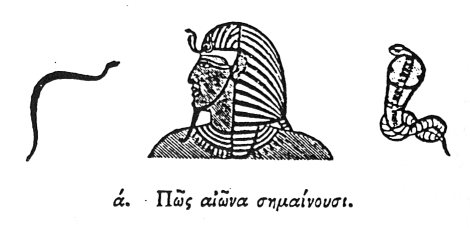 1
1Hieroglyphics of Horapollo, tr. Alexander Turner Cory, [1840], at sacred-texts.com
To denote Eternity 2 they depict the SUN and MOON, because their elements are eternal. But when they would represent Eternity 2 differently,
they delineate a SERPENT with its tail covered by the rest of its body: the Egyptians call this Ouraius, 1 which in the Greek language signifies Basilisk: 2 And they place golden figures of it round the Gods. The Egyptians say that Eternity is represented by this animal; because of the three existing species of serpents, the others are mortal, but this alone is immortal; and 3 because it destroys any other animal by merely breathing upon 4 it even without biting. And hence, inasmuch as it thus appears to have power over life and death, they place it upon the head of the Gods.
II. Head of a God with the Basilisk upon it. The basilisk often passes over the head, and is occasionally found passing round it.
III. Denotes Immortality.—Sharpe, 186, 191.
5:2 Eternal power?—a definite period?—an age?
6:1 ΟΥΡΟ, in Coptic, signifies a king. Jab. Champ. Tat.—Morell suggests Οὐβαῖος, as a derivative from אוב, Ob, a serpent.
6:2 The Cobra Capella.—Hasselquist is in error when he says that the Arabs call this serpent Haje. They call it Nasher: and Haiyeh or Hayyeh is a general name for a serpent.
6:4 Kircher suggests, "By the hiss."—See also Sanchoniatho Eus. Pr. Ev. lib. i. c. 10.
6:3 Qy. insert" Power?"